In the past, the thermal designer’s role was seen as one of predicting temperatures and ensuring that reliability limits are met for products. However, the role of an effective thermal designer is much more than that. We believe that thermal designers are both critical and most useful in the early conceptual stages of product design. This is where they provide the most “bang for the buck.” In addition, the thermal designer’s role is to challenge specifications that are often used merely for convenience or for legacy reasons, and to uncover the true requirements.
In any case, the ultimate goal of system thermal design is not the prediction of component temperatures, but rather the reduction of thermally associated risk to the product. This risk, inherent to today’s power-packed electronic systems, is manifested by compromised designs that do not meet projected schedules due to unforeseen thermal and/or reliability issues. Figure 1 illustrates this concept very well. Rather than wait until the later part of the development cycle (Figure 1a), the designer should be an integral part of the design right from the start (Figure 1b). The point of these curves is that your intuition or some quick hand calculations early in the design process is sometimes worth more than all of the CFD analysis work at the end of the design process.
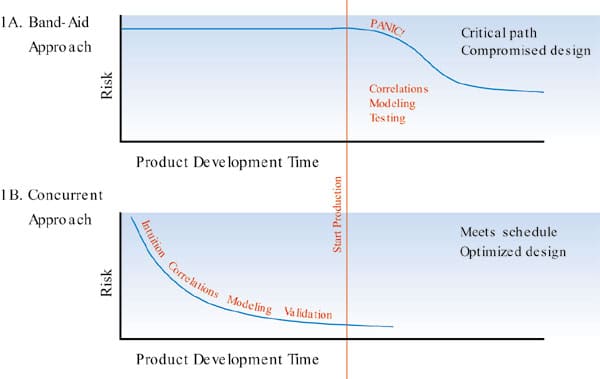 |
Figure 1. A comparison of approaches used in risk management for thermal design.Thermal design, therefore, is the process by which engineers use temperature and airflow predictions to uncover potential risk areas for the system engineering team (an example of which is shown in Figure 2). The key point here is that the thermal design engineer is an integral part of the systems engineering approach and it is critical that the thermal designer develop feasible solutions in a timely and reasonably accurate manner. Ultimately, the goal of the thermal design effort is to provide optimal designs that meet or exceed projected schedules and component requirements.
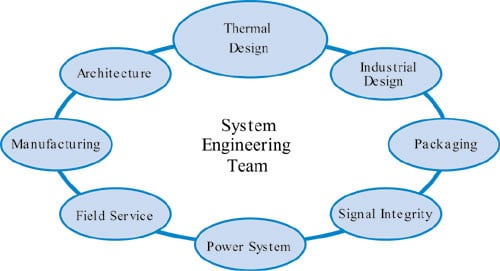 |
Figure 2. A typical system engineering team. It is important to identify the key players in the design and to understand the basic features.Many tools exist to assist thermal design engineers during this process, including heat transfer correlations, Flow Network Modeling (FNM), Computational Fluid Dynamics (CFD), and experimental measurement techniques. The key to efficient and comprehensive thermal design is not necessarily to choose the “best” tool for design, but rather to use the tools in a way that gets an adequate answer quickly so that the systems engineering team can make timely design decisions.
This article presents the thermal design methodology used by the authors to design several enterprise servers. Relying upon this methodology, we were able to systematically reduce risk throughout the product design cycle for each of the servers. In each case. the result was that the designs met the project schedule while requiring no changes to component thermal solutions, air movers, or mechanical packaging. Readers interested in how this technique was actually applied will find a detailed design example published in the ITHERM 2002 proceedings [1].
Thermal Design Methodology
The framework of this thermal design methodology was first introduced in 1997 by Biber & Belady and later evolved into what we now call the “Enhanced Product Design Cycle”[2]. According to this method, the development cycle consists of three distinct phases: Concept Development, Detailed Design, and Hardware Test. During each phase, the most applicable and expedient thermal design tools are used, as proposed in Figure 3. Thus, the methodology promotes a “fluid” process in which the predictions of tools used in the first phase are compared with subsequent predictions as the design enters the next phase and new tools are adopted. In this way, each step is validated and the thermal designers can test their intuition and the assumptions of their earlier work.
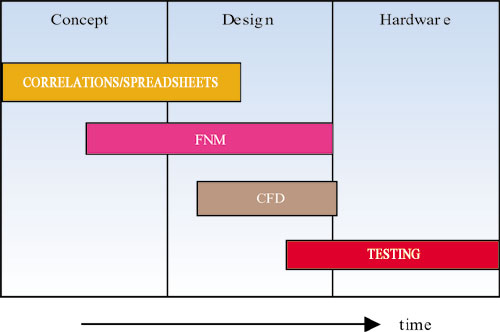 |
Figure 3. Enhanced product development cycle.
Concept Development
The Concept Development Phase is the initial stage in the product design cycle. At the start of this phase, the product concept is in its infancy. This phase is characterized by rapidly changing product layouts and requirements as representatives from the systems engineering team meet to discuss requirements and to develop new ideas. Here, the goal of the thermal designer is to analyze scenarios thoroughly, yet rapidly as well as offer design suggestions for improvement in real time. This phase concludes in a single product layout that meets or exceeds all requirements. At the conclusion of this phase, the thermal designer has:
- Completed a preliminary packaging concept (board through cabinet level) that can support the power dissipation of the unit.
- Completed preliminary air-mover selection, including size, number, location, and orientation.
- Sized and placed critical component heat sinks to ensure that adequate volume is available.
- Estimated the air temperature rises through all exhaust paths of the product.
- Identified areas of thermal risk and proposed design improvements necessary to mitigate these risks.
Concept Development Phase Thermal Tools: One of the most overlooked yet powerful tools that the seasoned thermal designer has is his or her intuition. In a matter of seconds, the thermal designer can leverage past experiences to provide a “gut” response that may not be accurate but is, in fact, good enough. These “gut” responses allow real-time sorting of many concepts and offer incredible “bang for the buck” for system engineering teams. In order to do this, the thermal designer needs to develop a sense of intuition, which necessitates constant validation by using tools.
Based upon their ease of use, quick solve times, and limited required input data (usually geometry and fluid data only), the common tools used in the concept phase are generalized correlations for heat transfer and fluid flow (i.e., hand calculations), spreadsheets (such as heatsink design optimizers), and Flow Network Modeling (FNM) techniques. FNM tools can be as simple as solving a network of resistances (both thermal and fluid) either with hand calculations and spreadsheets, or by using commercially available tools. Details of FNM techniques can be found in [1].
FNM techniques are easy to master as long as the 2D air flow paths can be clearly defined. In some cases, 2D flow path prediction is not possible and advanced techniques such as CFD or testing may be warranted. Regardless of whether FNM-specific software or spreadsheets are used, solutions are gained within seconds. This is extremely important in this phase of the development cycle.
Detailed Design
Once a single layout has been agreed upon, the Detailed Design phase of work begins in earnest. The thermal designer must now focus on identified areas of thermal risk within the product. Here, thermal analyses become more detailed (and time consuming), while results become more refined. Experimental measurement and construction of mockups of system-critical areas may be required for input into models or to gain information concerning product areas that are difficult to model. The ultimate goal of the thermal designer is to dig deeply into critical areas and to offer design suggestions, which can facilitate an optimal product design that meets or exceeds the project schedule and reliability goals.
Detailed Design Phase Thermal Tools: Tools commonly used in the electronics industry for detailed thermal design are Computational Fluid Dynamics (CFD) and Finite Element Analysis (FEA) solvers. Typically, these types of analyses require longer setup/solve times and more detailed input data. Three dimensional (3D) modeling or simplification of existing 3D Computer Aided Design (CAD) models may be required. User experience is required for the most accurate results. Furthermore, based upon system size and complexity, empirical sub-system flow resistance data may be acquired using flow-bench testing of fans, heat sinks and subsystems. CFD solvers marketed for the electronics industry afford designers the ability to perform heat transfer calculations in addition to fluid flow solutions. FEA analyses may be required to solve for component, interconnect, or board temperatures once global airflow rates or heat transfer coefficients are calculated.
Hardware Test
Once product prototypes are available, the Hardware Test phase begins. The goal of the thermal designer here is to measure critical components and areas of risk experimentally within the product to verify the design. At this point, there should be no surprises. Additionally, measurements are compared to estimates in order to “calibrate” or fine tune earlier models (calibrated models can be used in future studies). These comparisons are used to determine the accuracy of initial predictions and to help the designer develop “thermal intuition”.
Hardware Test Phase Thermal Tools: While the most common tool for temperature measurement is certainly the thermocouple, additional tools, such as thermistors, resistance temperature detectors (RTDs), thermochromic liquid crystals, thermopiles, and infrared imaging techniques, are also available. Air velocity measurement is also valuable during this phase. Classic hot wire anemometers provide the most precise measurements (i.e., speed and direction), but can be fragile, difficult to calibrate, and expensive. Newer “rugged” hot wire multi-channel probes that measure speed and temperature are also available.
Methodology Summary
Figure 4 shows the impact the thermal engineer can make on the product. The further to the left that issues and solutions are identified, the more positive the impact upon the product and product schedule. At some point, the thermal engineer can have a negative impact (further to the right) by identifying problems late and requesting changes when the design has become relatively fixed. This is not where the thermal engineer wants to be. It is our contention the salary/raises afforded thermal engineers will follow this curve as well.
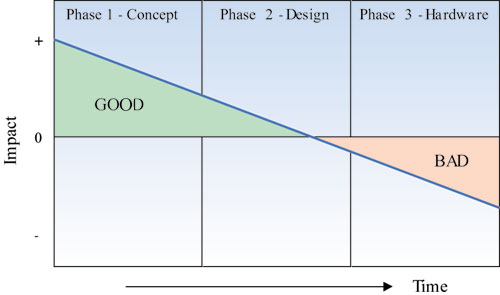 |
Figure 4. The thermal designer’s impact on the product schedule.
Risk Management
Figure 5 illustrates the importance of using the right tool at the right time. The red curve represents the risk level throughout the development cycle if only intuition, simple hand calculations and spreadsheets are used prior to testing the hardware. The green curve shows the risk level throughout the development cycle if a complete suite of tools is used. Note, in this case, the methodology approaches the ideal risk curve as a result of using the modeling technique that matches the design’s fluidity.
The key to minimizing the risk early is to use the tool that gets a reasonable answer most quickly. In addition, Figure 5 also shows that in the case of the green curve, the same risk level is reached in about a quarter of the time shown for the red curve. This implies that an engineer using the technique proposed can be four times more productive.
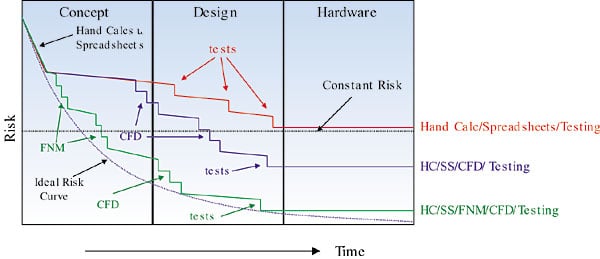 |
Figure 5. Using the right tools for risk management.
Conclusions
The focus of the proposed methodology is the systematic reduction of product risk through the careful application of available thermal design tools and techniques. When applied to the design of the servers, the methodology has shown to provide adequate and timely results. The key advantages of the proposed methodology are that it:
- Enables a low risk design, which meets project schedules without necessarily having exact temperature/airflow predictions.
- Utilizes an optimum combination of design tools to increase productivity and reduce design time.
- Exhibits no a priori preference for a given design tool, and emphasizes the use of whichever tool makes sense at the time. The key is to get the right data to make the right design decisions.
References
- Minichiello, A. and Belady, C., ” Thermal Design Methodology for Electronic Systems”, Proceedings of the ITHERM 2002 Conference, May 2002, pp. 696-704.
- Biber, C. and Belady, C., “Pressure Drop Prediction for Heat Sinks: What Is the Best Method?”, Proceedings of InterPACK ’97 Conference, Mauna Lani, Hawaii, EEP-VOL-19-2, ASME, 1997, pp. 1829 -1835.










